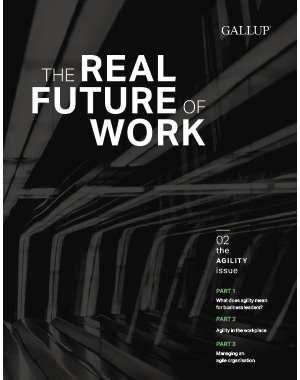Story Highlights
- The coronavirus creates new pressure for agile transformation
- In France and the U.K., employees perceive low agility
- Expand agility beyond the C-suite
Many leaders felt they had rapidly and profoundly increased agility over the last few years. The pandemic accelerated the process, forcing many businesses to be more nimble and much more decentralized. This acceleration allowed decision-making and execution to be faster than even leaders thought possible.
It really is an extraordinary transformation, and leaders should be impressed with it.
But they should also know that their employees' perceptions of what makes an agile culture may be very different from their own -- and that discrepancy may present a problem in their business continuity plans.
Perceptions of an agile culture are persistently low in France and the U.K.
As recent Gallup workplace research in France and the U.K. shows, very few employees strongly agree they have the mindset, tools and processes to respond quickly to business needs or meet market needs.
In fact, as long as Gallup has tracked these measures, the percentage of French or British employees who said they strongly agree their company had the two basic components of an agile culture -- tools and processes and the right mindset -- has never reached a majority.
As of April 2020, 21% of non-managers in the U.K. and France strongly agreed with the statement, "In my company, we have the right tools and processes to respond quickly to business needs." Roughly one in four (24%) of that same group strongly agreed that in their company, they have the right mindset to respond quickly to business needs, and just 20% agreed they have the speed and agility to meet customer and marketplace change.
That's alarming.
Gallup research in 2019 revealed that when workers perceived their company to have the mindset and the tools and processes of an agile culture, they're more likely to believe that their organization is perfect for customers, that their company is ahead of the competition, that the company's financial future is secure, and that their employer is successful and growing.
Those qualities inspire hope and may shore up engagement, which are vital elements of workplace culture and influence productivity -- even more so in a workforce facing a difficult business environment.
French and British workers' low perceptions of agility may reflect workstreams that have been stalled by work constraints, budget restrictions, or marketplace changes, but the data trend suggests workers' doubts about local agile culture are entrenched.
As the analysis indicates, the result of this effect is that employees may be less able to respond quickly or successfully to business needs and that they are more cynical about leadership.
Much more cynical. When asked whether they agree with the statement, "I have confidence in the leadership of the company to successfully manage emerging challenges," 84% of British workers who think their company is agile strongly agree, as do 74% of French workers.
Of those who are skeptical of local agile culture, 10% or less in either country have faith in the leadership of their companies to manage challenges.
Develop the eight attributes of an agile culture.
Every employee gets signals from their work environment -- where the opportunities and barriers are, which risks they can take and which they can't, who to go to for help and who to avoid.
This is extremely valuable information that shapes the employee experience and, ultimately, overall business performance. And in most companies, individual contributor-level employees have the closest view of procedures and processes.
So, if the signals workers receive tell them to go slow and deal with obstacles, agility is probably in trouble. That situation is likely to compound when tight budgets, reduced headcount and a poor economy make corporate resources scarcer and customer centricity more urgent.
So, leaders need to create the conditions of an agile culture, which Gallup research indicates requires eight fundamental cultural attributes:
- cooperation
- speed of decision-making
- trial tolerance
- empowerment
- technology adoption
- simplicity
- knowledge sharing
- innovation focus
Leaders should establish each attribute and ensure it is experienced throughout the organization so that managers and employees can behave with the same speed and focus on customer centricity as leaders.
And the simplest method for creating an agile culture is clearing away obstacles.
Consider these three examples of blockers to remove:
-
Overly complex processes should be streamlined to speed up delivery. Get rid of stupid rules and low-value activities and time wasters. Complexity is like a weed in a garden -- it can always creep back. Whenever you feel like you have it solved, do another review.
-
Silos should be dismantled to facilitate communication and collaboration. Speak up about poor practices. Do not hesitate to challenge more senior people about things like poor meeting culture, unclear assignments, over-analysis, etc.
-
All employees should have a line of sight to the customer -- and enough agency to be truly customer centric. Focus on adding value. Prioritize. Reassess the priority list as new elements are added.
A well-designed review -- one that includes stakeholders of all ranks -- can identify obstacles to creating a real agile culture and show leaders how to clear them.
Pushing agile forward.
The right culture review can also inspire more faith in leadership.
In addition to the finding that French and British employees who perceive their culture as agile are also more confident that their company's leadership can successfully manage emerging challenges, these employees are also more likely to be confident that they will be an important part of their company in the future.
Maybe it's because leaders at those organizations have implemented the tools, processes and mindset an agile culture requires -- or maybe it's because their leadership during the pandemic has earned employees' benefit of the doubt.
In any case, leaders feel they're able to move quickly and more nimbly than they could -- or ever thought they could -- before now.
The past few months have brought new ways of working, new ways of collaborating, new ways of decision-making and new forms of empowerment to companies all over the world.
But if those capacities are confined to the C-suite, a culture of agility quickly peters out. Businesses need to create cultures that intensify that power by democratizing it.
So, wherever a more agile way of working, collaborating, decision-making and empowerment occurs, it should be recognized as a success and those success stories must be told -- especially when the success is at the work-group level.
Recognizing success inspires more of the same and helps enculturate agility.
That's key. Agility accelerates success when it becomes "the way we do things around here." That potential is dammed up in most British and French companies.
If their leaders decide to enable an agile culture instead, they'll tap a fuel source for their business continuity plans that will speed their recovery -- and energize employees for whatever comes next.
Imagine what your culture could do.
- Read our paper, "Gallup's Approach to Culture: Building a Culture That Drives Performance."
- Learn how Gallup can transform your culture to deliver tangible results.
- Equip managers to support culture change. Explore our virtual courses.





